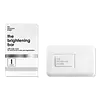What's inside
What's inside
 Key Ingredients
Key Ingredients

No key ingredients
 Benefits
Benefits

 Concerns
Concerns

 Ingredients Side-by-side
Ingredients Side-by-side

Sodium Palmate
CleansingSodium Palm Kernelate
CleansingWater
Skin ConditioningGlycerin
HumectantCoconut Acid
CleansingTitanium Dioxide
Cosmetic ColorantSodium Citrate
BufferingButyrospermum Parkii Butter
Skin ConditioningSodium Gluconate
Skin ConditioningSodium Chloride
MaskingKojic Dipalmitate
EmollientEugenia Caryophyllus Flower Oil
MaskingCitrus Medica Peel Oil
Juniperus Virginiana Oil
MaskingLavandula Angustifolia Oil
MaskingPogostemon Cablin Leaf Oil
MaskingCedrus Atlantica Bark Oil
MaskingRosmarinus Officinalis Leaf Oil
MaskingThymus Vulgaris Oil
MaskingGlycyrrhiza Glabra Root Extract
BleachingSodium Palmate, Sodium Palm Kernelate, Water, Glycerin, Coconut Acid, Titanium Dioxide, Sodium Citrate, Butyrospermum Parkii Butter, Sodium Gluconate, Sodium Chloride, Kojic Dipalmitate, Eugenia Caryophyllus Flower Oil, Citrus Medica Peel Oil, Juniperus Virginiana Oil, Lavandula Angustifolia Oil, Pogostemon Cablin Leaf Oil, Cedrus Atlantica Bark Oil, Rosmarinus Officinalis Leaf Oil, Thymus Vulgaris Oil, Glycyrrhiza Glabra Root Extract
Ingredients Explained
These ingredients are found in both products.
Ingredients higher up in an ingredient list are typically present in a larger amount.
This ingredient is also known as shea butter. It is an effective skin hydrator and emollient.
Emollients help soothe and soften your skin. It does this by creating a protective film on your skin. This barrier helps trap moisture and keeps your skin hydrated. Emollients may be effective at treating dry or itchy skin.
Shea butter is rich in antioxidants. Antioxidants help fight free-radicals, or molecules that may harm the body. It is also full of fatty acids including stearic acid and linoleic acid. These acids help replenish the skin and keep skin moisturized.
While Shea Butter has an SPF rating of about 3-4, it is not a sunscreen replacement.
Shea butter may not be fungal acne safe. We recommend speaking with a professional if you have any concerns.
Learn more about Butyrospermum Parkii ButterCoconut Acid isn't fungal acne safe.
Titanium dioxide is a mineral UV filter widely used in sunscreens and cosmetics.
It is one of only two UV filters officially classified as “mineral” by regulatory agencies, the other being zinc oxide.
Titanium dioxide provides broad-spectrum protection mostly in the UVB and UVAII range, with some protection in the UVAI range.
While its UVA protection isn’t as strong as zinc oxide’s, the difference is minor.
A common myth is that mineral UV filters reflect UV light. However, modern research shows titanium dioxide absorbs UV radiation like chemical filters (~95% absorption & 5% reflection).
Thanks to its non-irritating nature, titanium dioxide is suitable for sensitive, acne-prone, or redness-prone skin. It is unlikely to cause "eye sting" like other sunscreen ingredients.
A major drawback of this ingredient is its white cast and thick texture. This is why mineral sunscreens often leave a white cast and are less cosmetically elegant than chemical/hybrid sunscreens.
To improve white cast and spreadability, micronized or nano-sized titanium dioxide is often used.
There are ongoing concerns surrounding nano-titanium oxide's impact on marine ecosystems.
There is no conclusive evidence that any form of titanium oxide (or any other sunscreen ingredients) will cause harm to marine ecosystems or coral reefs. The science is still developing but many consumers are keeping a close eye on this issue.
Please note, many destinations have reef-safety sunscreen rules. For instance, the U.S. Virgin Islands advises all visitors to use non-nano mineral sunscreens.
Nano mineral sunscreens once raised safety concerns about absorption into skin.
Extensive research has shown that they do not penetrate healthy or damaged skin; they remain safely on the surface and the top layer of dead skin (stratum corneum).
You'll likely find titanium dioxide bundled with alumina, silica, or dimethicone. These ingredients help make titanium dioxide highly photostable; this prevents it from interacting with other formula components under UV light.
Learn more about Titanium Dioxide